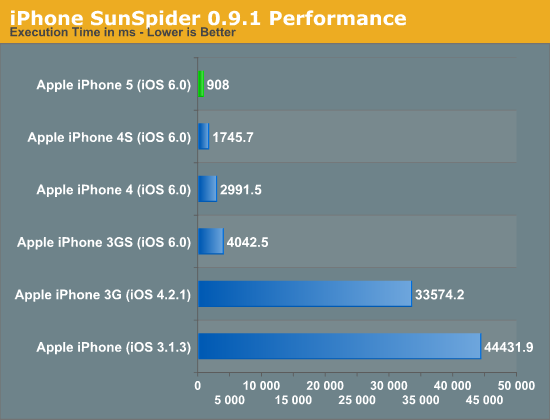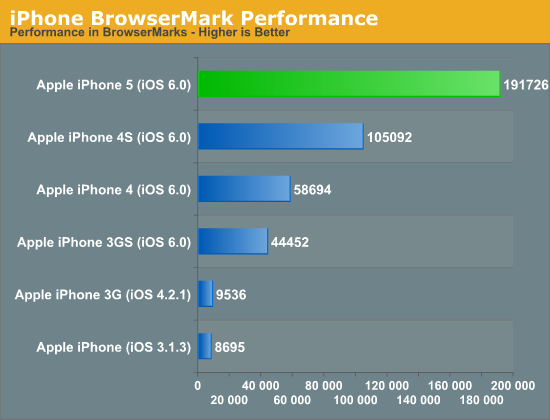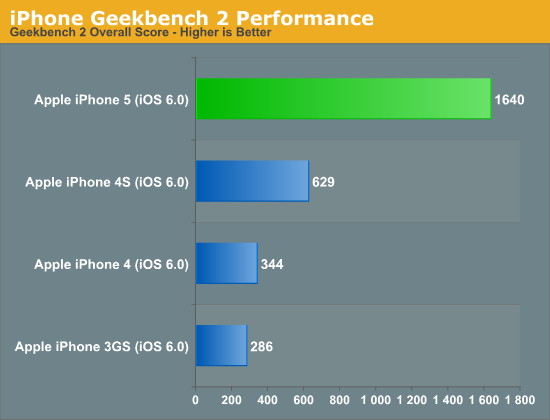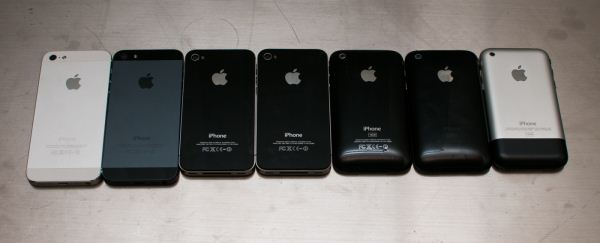The iPhone 5 Review
by Anand Lal Shimpi, Brian Klug & Vivek Gowri on October 16, 2012 11:33 AM EST- Posted in
- Smartphones
- Apple
- Mobile
- iPhone 5
Six Generations of iPhones: Performance Compared
Section by Anand Shimpi
Cross platform smartphone benchmarks are interesting, but they do come with their own sets of issues. Before we get to that analysis however, let's look at how the iPhone's performance has improved over the past six generations. Luckily Brian has a set of all of the iPhones so he was able to run a few tests on all of the devices, each running the latest supported OS.
We'll start with SunSpider 0.9.1, our trusty javascript performance test:

The transition from iPhone to iPhone 3G shows you just how much additional performance you can squeeze out of simply a software change. There's likely even more that could be squeezed out of that ARM11 platform, unfortunately newer versions of Safari/iOS aren't supported on the iPhone 3G so we're left with a runtime that's around 37x the length of a single run on the iPhone 5.
The rest of the devices support and run iOS 6, so we're at least on a level software playing field. The performance boost from one generation to the next is quite significant still. Going by this chart alone, the best balance of minimal upgrades and maximum perceived improvement would be from the original iPhone to the 3GS then again from the 3GS to the 5.

The BrowserMark results tell a similar story. The jump from the ARM11 based iPhone/iPhone 3G to the 3GS running iOS 6 is huge. Both the 4S and 5 offer doublings in performance, albeit for different reasons. The 4S delivered a doubling thanks to a doubling of core count and a move to the Cortex A9, while the iPhone 5 doubled performance through a much higher clock speed and microarchitectural improvements.
Finally we have Geekbench 2, which only runs on the iOS 6 supported devices so we say goodbye to the original iPhone and iPhone 3G:

None of the jumps looks as dramatic as the move to the iPhone 5, but we already know why. The Swift CPU architecture does a great job improving memory performance, which shows up quite nicely in a lot of the Geekbench 2 subtests.
On the PC side we often talk about 20% performance improvements from one generation to the next being significant. It's clear that the mobile SoC space is still operating along a hyper Moore's Law curve. The rate of progress will eventually slow down, but I don't see that happening for at least another couple generations. The move to ARM's Cortex A15 will be met with another increase in performance (and a similarly large set of power challenges), and whatever comes next will push smartphones into a completely new category of performance.












276 Comments
View All Comments
Zink - Wednesday, October 17, 2012 - link
That's would be light enough to float.manders2600 - Wednesday, October 17, 2012 - link
It would be really nice to see some of these benchmarks next to an Android device running Jellybean.From my personal experience with the Galaxy Nexus, all of the benchmarks run in this article improve dramatically (many by more than 50%) with that OS version.
I'm really curious to see what a comparison between the performance of an S4 (Krait) and an A6 would be in that situation, since so much of the CPU tests are impacted by OS.
manders2600 - Wednesday, October 17, 2012 - link
But great read, though!. . . sorry, forgot to include that.
Tremendous research went into this, and it is well appreciated.
phillyry - Sunday, October 21, 2012 - link
I agree.I mean it's good that you have the devices on their native OSes but showing them on their upgraded OSes would bee good too 'cause it would add another realistic point of comparison.
cjl - Wednesday, October 17, 2012 - link
In the article, you state:"Which brings us to the next key detail with the anodization process: typically, the thickness of the anodization is half the thickness of the base aluminum. So if you had an aluminum plate that was 1mm thick, post-anodization, you would end up with a 1.5mm thick plate"
You also talk about the pore density in anodizing, and claim that apple has a pore density higher than most.
To put it quite simply, all of this is wrong.
Anodizing creates a layer that is on the order of micrometers thick. How thick the coating is depends on the details of the anodizing process, not on the thickness of the base metal. Most decorative anodized coatings are a few micrometers thick, and as you discussed, it's really not that hard to scratch them. Thicker anodizing, sometimes known as hard anodizing, is possible, and it can be done to thicknesses of 25 micrometers (0.001") or greater - from what I can find, over 100 micrometers is possible. These thicker coatings provide pretty substantial scratch resistance, and significant increases in durability, but they require substantially more process control, and it is more difficult to get a consistent coating. Note that even the thickest of these coatings is around 0.006 inches (150 micrometers) or so, which is far, far less than a 2:1 ratio on the aluminum on which it is applied. Interestingly, this thickest possible coating is about what you speculate is the thickness on the iPhone 5, but given its propensity for scratching, I sincerely doubt this to be the case.
Now for pores. The pore size on anodized aluminum is a few tens of nanometers. There is absolutely no way that you could visibly see this, or any improvement in this from one product to the next. This is 20 times smaller than the smallest wavelength of visible light. Quite simply, you can't possibly see this, and this won't be any different between Apple and any other manufacturer.
That having been said, there are some slight differences in pore structure between coatings. They won't make a significant visible difference (if any at all), but they can make a difference in durability. Specifically, hard anodized coatings (as mentioned above) tend to have thicker walled pores relative to the pore diameter. This again helps increase the wear resistance of hard anodized parts.
TL,DR: The iPhone probably has a really thin anodizing coat (<10 um). The pores are never visible on anodizing. Anodizing can be done, even on very thin aluminum, such that it would be incredibly scratch resistant.
Jaguar36 - Wednesday, October 17, 2012 - link
+1 on this.Not sure where the Vivek got the 2:1 ratio for an anodization thickness, but its nonsense. If you have a 0.25" thick part you're not going to be getting a 0.125" thick anodization. Anodization is usually less than 0.001" thick, and has no relation to the base part thickness.
Cibafsa - Wednesday, October 17, 2012 - link
Whilst Android based device manufacturers do not have to bear the majority of the SOC design/manufacture costs or the OS development costs, they do not share in the iAds/App Store type revenue Apple does.Surely it is Apple that can afford to cut prices to cost or even lower. Perhaps it is the Android manufacturers that have to worry about cheap high end phones.
Will be interesting to see what price point the iPad mini comes in at.
steven75 - Wednesday, October 17, 2012 - link
Most people following this industry are well aware by now that the App Store is run near break-even and iAds were not very successful.Calista - Wednesday, October 17, 2012 - link
A good and through review but I found it a bit too long-winded. An example would be the following example straight from the first page:'All previous iPhones have maintained the same 3.5-inch, 3:2 aspect ratio display. With the rest of the world quickly moving to much larger displays, and with 16:9 the clear aspect ratio of choice, when faced with the decision of modernizing the iPhone platform the choice was obvious.'
It could have been shortened to:
'iPhone 5 moves from the previously used 3.5", 3:2 aspect ration to a 4", 16:9 aspect ratio as common among smartphones of today. They kept roughly the same width while increasing the hight with xx mm. The resolution went from 960x640 to 1136x640."
More information is contained in the rewritten part while at the same time being shorter. Don't forget that this is Anandtech and I assume every single one of your readers are familiar with both the size and resolution of previous iPhones as well as common aspect ratios used on phones.
The same could be said about the design. I'm sure every single one of your readers have held and played with an iPhone 4/4s, and so when comparing to those two you guys could have kept a lot shorter.
phillyry - Sunday, October 21, 2012 - link
Read better as originally posted than as you rewrote it.